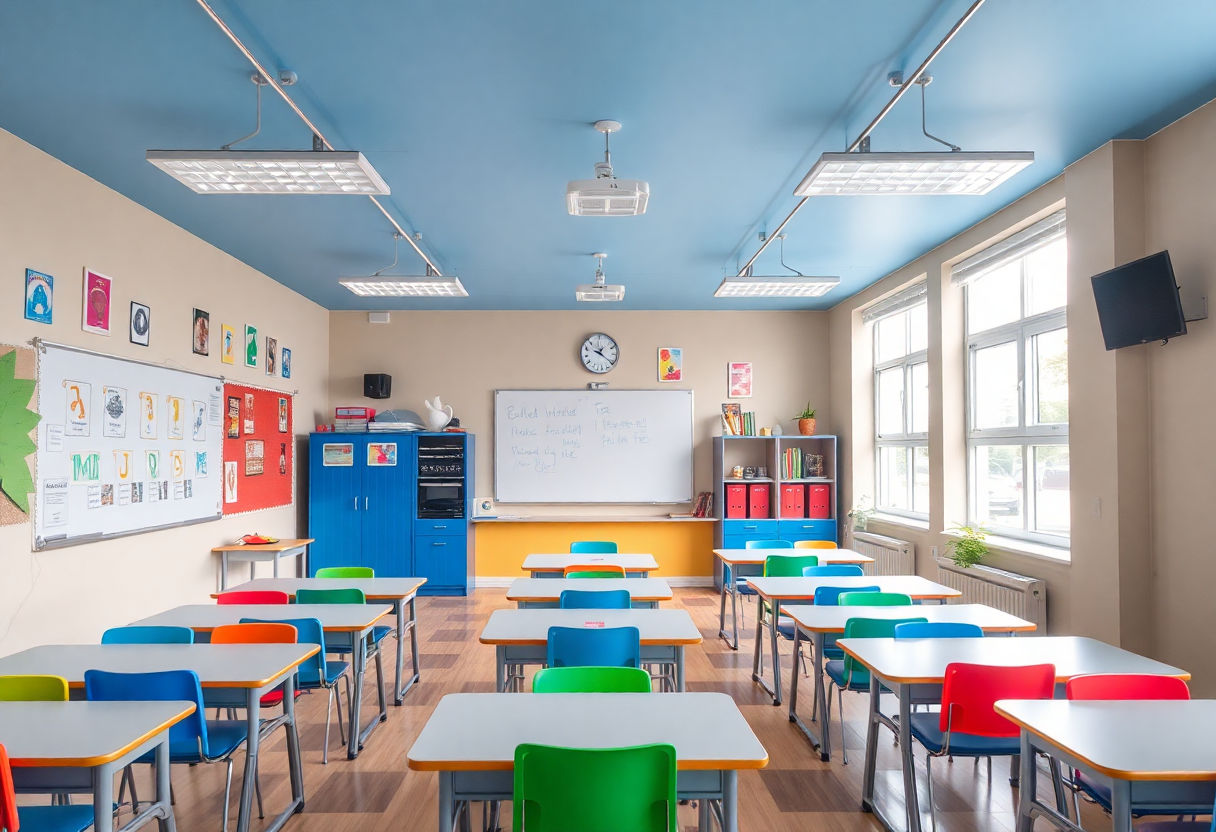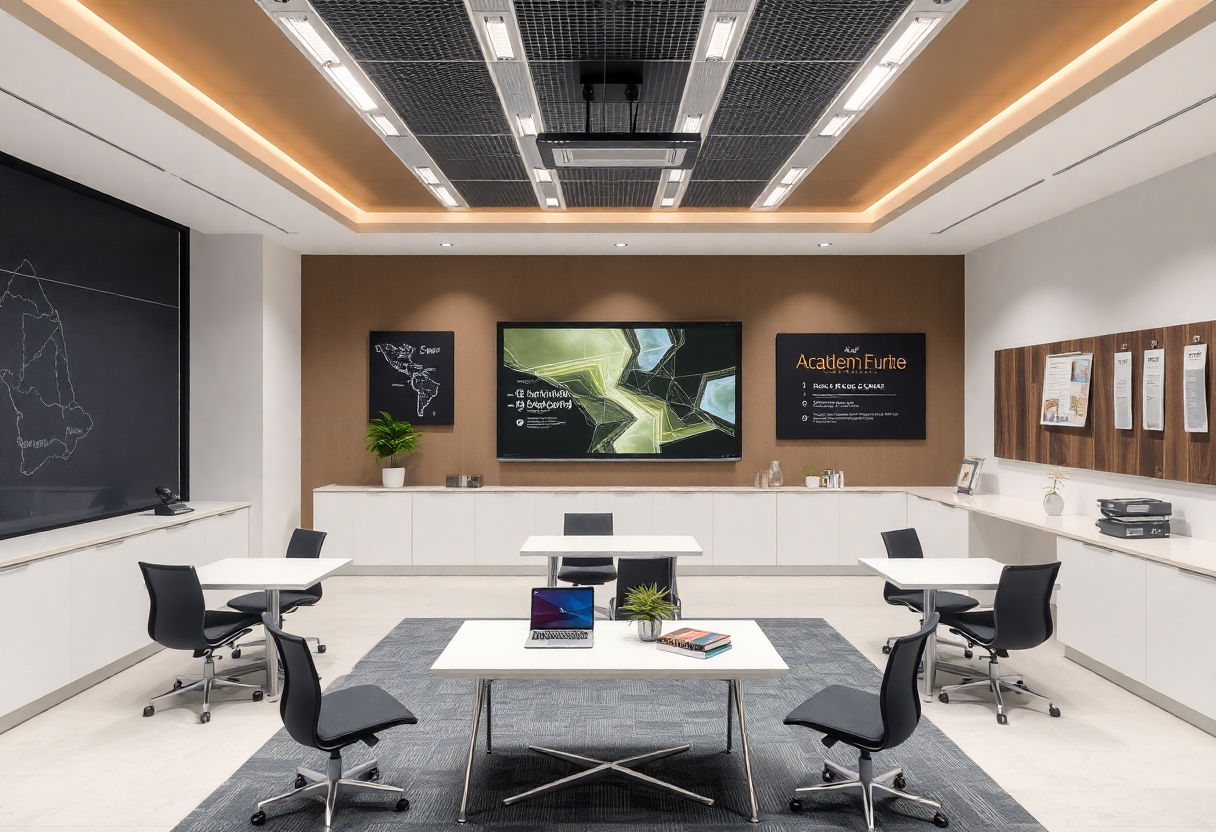Innovative design trends are revolutionizing academia rooms, unlocking the potential for maximum space utilization and fostering dynamic learning environments. As educational institutions aim for optimal use of their facilities, reimagining space becomes crucial. This transformation is driven by the adoption of flexible furniture solutions and integrating technology, which together create adaptive and multifunctional spaces. Additionally, the strategic use of natural light and thoughtful environmental design enhance ambiance and learning efficiency. As you explore these insights, witness how these advancements not only reshape physical spaces but also the future of education itself.
Key Takeaways
- Innovative design trends in academia rooms are pivotal in maximizing space and enhancing learning environments.
- Optimized design directly impacts educational outcomes by fostering a supportive and adaptable learning space.
- The integration of flexible furniture and technology allows for multi-functional and dynamic use of academic spaces.
- Balancing open and closed-door spaces is crucial for encouraging collaboration while maintaining focus.
- Future trends in academia room design emphasize sustainability, technology integration, and innovative space utilization.
The Importance of Space Optimization in Academic Settings
Optimizing space in academic settings is crucial as it directly influences both the educational environment and the overall effectiveness of learning experiences. With increasing student populations and the need for multifunctional spaces, educational institutions face the challenge of making the most out of their available space.
Enhanced Student Experiences: Thoughtfully designed spaces can greatly enhance student engagement and motivation. By creating areas that are dynamic and adaptable, students are encouraged to participate and collaborate more freely. Well-optimized environments can accommodate various learning styles and activities, from group discussions to individual study sessions.
Improved Academic Outcomes: Research indicates that a well-organized physical environment can lead to better academic performance. Students in spaces that minimize clutter and maximize accessibility are more likely to focus and absorb information. Effective space utilization can support diverse teaching methods, ranging from lectures to project-based learning, ensuring that educational objectives are met efficiently.
Collaboration and Innovation: By optimizing space, institutions can foster a sense of community and innovation. Collaborative spaces enable students and faculty to work together seamlessly, exchanging ideas and knowledge. This fosters a culture of innovation where creativity is nurtured, and new ideas can flourish.
Furthermore, space optimization often involves integrating technology, which can further augment the learning experience. Smart design solutions ensure that classrooms are not only functional but also inspiring. As educational demands evolve, so too must our approach to space, ensuring environments that are not only accommodating but also invigorating.
Flexible Furniture Solutions
Flexible furniture has emerged as a pivotal component in the pursuit of maximizing space within academia rooms. Its adaptability allows educational environments to evolve in tandem with diverse teaching methods and learning styles, fostering an atmosphere conducive to both collaboration and individual focus.
Adaptability for Various Learning Styles
Flexible furniture can be reconfigured swiftly to support a multitude of educational activities. For instance, modular seating arrangements enable quick transitions from lecture-based setups to collaborative group workstations. This adaptability caters to kinetic learners who thrive in dynamic spaces, as well as auditory learners who benefit from more traditional classroom layouts. The ability to reconfigure a learning space emphasizes the trend towards personalization and inclusiveness in education.
Enhancing Space Utility
Efficient use of space is paramount in academic settings where footprint often dictates the scale of learning activities. Furniture designs that integrate storage and multifunctional use—such as desks with foldable sections or chairs with stowaway tablet arms—ensure that every square foot is utilized optimally. This not only reduces clutter but also accommodates fluctuations in student numbers and activity requirements.
Supporting Innovative Teaching Methods
Modern pedagogical approaches often emphasize student engagement through interactive and project-based learning. Flexible furniture enables instructors to seamlessly integrate these methods by providing the necessary infrastructure to shift between various instructional modes. Instructors can effortlessly orchestrate transitions from solitary tasks to group projects, thereby enriching the educational experience.
In summary, the strategic implementation of flexible furniture solutions allows academic institutions to maintain nimble and efficient learning environments. This fosters a space that can adapt to the evolving needs of both educators and students, promoting an enriched and effective educational framework.
Integrating Technology for Effective Learning

In the evolving landscape of educational spaces, the integration of technology is pivotal to creating multifunctional learning environments. By harnessing modern technological tools, academia rooms can transcend traditional educational constraints, supporting both dynamic and static teaching methods.
One of the primary benefits of integrating technology is its ability to support interactive learning experiences. Smartboards and interactive projectors transform typical lessons into engaging, participatory sessions, allowing students to interact directly with learning materials. This interaction enhances understanding and retention, catering to various learning styles.
Moreover, technology facilitates the creation of flipped classrooms, which encourage students to engage with lectures and materials online at their own pace, freeing class time for guided, hands-on activities. This approach fosters a blended learning environment where students can explore topics deeper during class with expert guidance.
Furthermore, the incorporation of digital collaboration tools empowers students to work on group projects seamlessly, whether physically present or participating remotely. Platforms such as virtual workspaces offer a centralized place to share ideas and resources, bridging geographical divides and fostering a spirit of collaboration.
The deployment of adaptive learning technologies also plays a crucial role, using artificial intelligence to tailor educational content to individual student’s needs. Such systems provide personalized learning paths, ensuring that each student progresses at an optimal pace.
Utilizing technology in academia rooms not only maximizes the utility of physical space but also enriches the educational experience by promoting inclusivity and accessibility, ensuring all students can engage effectively with the curriculum.
Open vs Closed-Door Spaces: Balancing Collaboration and Concentration

Open and closed-door spaces each present unique advantages for academic environments, demanding a careful balance to optimize both collaboration and concentration. Traditionally, open spaces are favored for their ability to foster communication and teamwork. These areas encourage students to engage with one another, sparking creativity and innovation. Open spaces are ideal for group projects, brainstorming sessions, and cooperative learning, where interaction is crucial.
Conversely, closed-door spaces are essential for activities that require focus and privacy. Study rooms, private offices, and enclosed classrooms provide an environment conducive to deep concentration, minimizing distractions. This setting is particularly beneficial for exams, individual tasks, and situations where confidentiality is paramount.
Implementing a hybrid model that incorporates both open and closed spaces can significantly enhance educational experiences. In practice, this involves designing academic environments that offer flexible use of space, allowing easy transition between different settings based on user needs. Modular walls or movable partitions can be employed to create adaptable spaces that cater to various activities throughout the day.
The challenge lies in optimizing acoustics and ensuring adequate soundproofing to maintain an appropriate noise level in both settings. Open spaces should incorporate sound-absorbing materials to mitigate disruptions, while closed spaces should ensure complete acoustic separation.
Designers and planners must also consider the psychological effects of open versus closed spaces. While open spaces can stimulate energy and enthusiasm, they may also lead to a sense of overexposure, potentially impacting productivity. Meanwhile, closed spaces might contribute to feelings of solitude, which could hinder the collaborative spirit essential in academia.
By strategically integrating the strengths of open and closed-door spaces, institutions can create a balanced learning environment that supports diverse educational needs.
Role of Natural Light and Environmental Design
Natural light plays a crucial role in creating an invigorating learning environment. Studies have shown that exposure to natural light can significantly improve student concentration and performance. It enhances the ambiance of academia rooms, fostering a positive atmosphere conducive to learning. Moreover, natural light reduces dependency on artificial lighting, leading to both environmental and economic benefits.
Incorporating sustainable environmental design is also pivotal in academia settings. By using eco-friendly materials and practices, educational institutions can minimize their carbon footprint and create healthier spaces for students and staff. Environmental design focuses on the holistic integration of a building’s architecture with its surroundings, ensuring that spaces are not only functional but also enriching.
Key benefits of integrating natural light and sustainable design include:
-
Improved Health and Well-being: Exposure to daylight is linked to better mood and increased energy levels. Meanwhile, utilizing non-toxic, sustainable materials promotes well-being by reducing exposure to harmful substances.
-
Increased Energy Efficiency: Leveraging natural light and sustainable materials can dramatically lower energy consumption, resulting in cost savings and a reduced environmental impact.
-
Enhanced Aesthetics and Functionality: Thoughtful design that merges functionality with environmental considerations leads to aesthetically pleasing and versatile academia rooms.
Emphasizing natural light and environmental design not only supports academic performance but also aligns with broader sustainability goals. Schools and universities adopting these practices demonstrate a commitment to innovation and responsibility, ultimately fostering more engaging and sustainable learning environments.
Acoustics and Sound Management in Academia Rooms

Proper acoustics and sound management in academia rooms are crucial for fostering an effective learning atmosphere. Classrooms and lecture halls that suffer from noise pollution or poor sound distribution can hinder both teaching and learning processes. By implementing strategic acoustic solutions, educational institutions can dramatically enhance auditory clarity and concentration.
Key strategies for effective acoustics and sound management include:
-
Soundproofing Materials: Installing ceilings and walls with sound-absorbing materials can significantly reduce ambient noise levels. Materials such as acoustic panels and specialized ceiling tiles are designed to absorb sound waves, minimizing echo and reverberation.
-
Furniture Layout: Thoughtful placement of furniture can aid in managing sound dispersion. Arranging seats in a staggered formation helps in distributing sound evenly throughout the room, ensuring that all students can hear the instructor clearly, regardless of their position.
-
Technology Integration: The use of audio enhancement systems such as microphones, amplifiers, and speakers can also contribute to effective sound management. These systems help project the instructor’s voice uniformly, making it audible to all students without strain.
-
Flexible Space Design: Designing rooms that can be easily reconfigured to accommodate various group sizes and teaching styles allows for better control over sound dynamics. Movable partitions and adaptable room layouts can be used to contain sound within specific areas, limiting its spread.
As one educational expert notes, “Optimal acoustics not only enhance speech intelligibility but also contribute to a more focused learning environment.” By adopting these measures, academia can ensure that their learning spaces are both functionally and acoustically optimized.
Color Psychology and Its Influence on Learning Spaces

Colors wield a profound influence on our emotions and cognitive processes, making them a pivotal component in the design of learning spaces within academic settings. The psychological impacts of colors can significantly affect students’ mood, concentration, and learning efficiency. Understanding and implementing color psychology in academia can lead to the creation of environments that enhance educational experiences.
Warm colors, such as reds, oranges, and yellows, tend to stimulate and energize, potentially increasing alertness and creativity. These hues can be strategically used in environments where interactive or physical activities are encouraged. For instance, incorporating warm colors into collaborative spaces might foster communication and dynamic student engagement.
Conversely, cool colors such as blues and greens are known for their calming effects, often associated with tranquility and focus. These colors are particularly effective in environments requiring concentration and focused learning, such as libraries or testing centers. Blue, for instance, can aid in stress reduction and improve task accuracy, making it ideal for individual study areas.
Neutral tones, incorporating shades of white, gray, and beige, can create a balanced and unintrusive atmosphere, allowing other colors to highlight specific zones of a room. Utilizing these tones ensures that the learning space is not overstimulating, which can be especially beneficial in minimizing distractions.
Moreover, the strategic use of accent colors can delineate spaces and functionalities within a multi-purpose room, providing visual cues and subtle wayfinding aids. This technique not only enhances spatial aesthetics but also reinforces the intended use of different areas, optimizing the educational impact of the learning environment.
Future Trends in Academia Room Design

Looking ahead, academia room designs are likely to incorporate cutting-edge technologies and a stronger emphasis on personalized learning environments. As educational institutions strive to keep abreast of evolving learning methodologies, several prominent trends are beginning to emerge:
-
Smart Classrooms: Future academia rooms will be equipped with smart technologies, such as interactive screens and voice-controlled devices, to facilitate seamless educational experiences. These tools will support customized learning pathways, catering to the diverse needs of students.
-
Sustainable Design: As sustainability becomes a core value in design philosophy, educational spaces will increasingly incorporate eco-friendly materials and energy-efficient technologies. This shift not only aligns with global environmental goals but also enhances the wellbeing of students and educators.
-
Biophilic Elements: Integrating nature into the learning environment is gaining momentum. Future designs will likely feature indoor plants, natural materials, and views of green spaces, all of which have been shown to boost concentration and reduce stress.
-
Adaptable Layouts: Versatility will be key, with rooms designed to transition effortlessly between traditional lectures and collaborative group work. Furniture and wall partitions might be easily reconfigurable, allowing for quick adaptation to various teaching styles and activities.
-
Wellness-Centric Spaces: Increasing awareness of mental health issues means academic institutions will likely create spaces that promote relaxation and stress reduction, featuring calming colors and quiet zones for reflection.
These trends indicate a move toward holistic and student-centric learning environments, promising to revolutionize how academic spaces are conceived and utilized in the years to come.
Conclusion
In maximizing space within academia rooms, innovative design trends serve as pivotal catalysts in enhancing educational environments. By combining flexible furniture solutions and technological integration, academic institutions can foster both dynamic learning and effective space utilization. The emphasis on natural light and acoustic management further refines these spaces, promoting optimal learning conditions. As these trends progress, academia rooms will increasingly adapt to diverse educational needs. Institutions are encouraged to embrace these design innovations, paving the way for a more versatile and engaging future in education.
Frequently Asked Questions
How can innovative design trends optimize space in academia rooms?
Innovative design trends such as flexible furniture, technology integration, and the use of natural light can maximize space efficiency by creating adaptable and multifunctional learning environments.
What role does furniture play in maximizing academia room space?
Flexible furniture solutions allow for quick reconfiguration of a space to adapt to different teaching methods and collaborative activities, thus enhancing space utility.
Why is acoustic design important in educational environments?
Proper acoustics and sound management are crucial in academia rooms to minimize distractions, thereby creating a more conducive learning atmosphere that enhances student focus and engagement.
How does color psychology influence learning in academia rooms?
The strategic use of color in academia rooms can affect mood and concentration levels, promoting a positive learning environment that can enhance academic performance and well-being.
What is the future of academia room design?
The future of academia room design lies in embracing technologies and sustainable practices that foster dynamic and interactive educational spaces, optimizing both physical and mental engagement for students.



